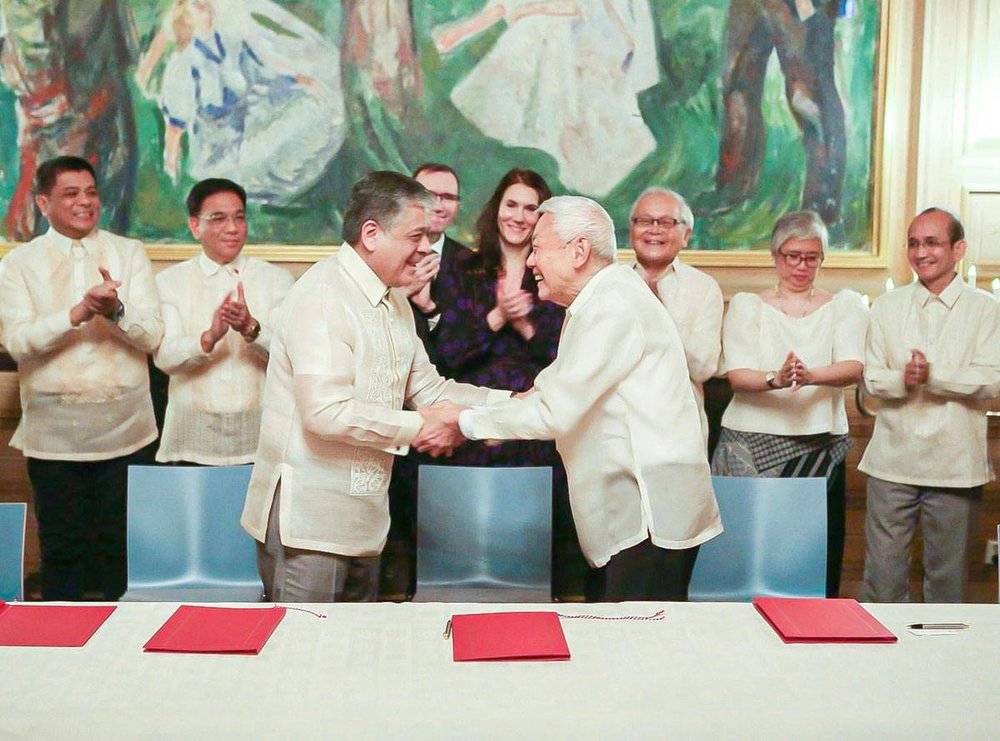Restart of Gov’t-NDF Peace Talks Must Address the Human Element

Philippine Secretary Antonio Lagdameo, Jr. and The National Democratic Front’s Luis Jalandoni shake hands after signing the peace agreement in Oslo, Norway last November 28, 2023 (Source: Mathias Rongved | Norway Ministry of Foreign Affairs)
After six years, the Philippine government and the National Democratic Front agreed to resume peace negotiations to end a half-century of bloody fighting between the government and Communist Party of the Philippines-NDF and their military wing, the New People’s Army, which has reportedly killed more than 40,000 people.
Naga City, 1 January 2024
As we entered the New Year, former National Democratic Front leader Satur C. Ocampo noted that “By all indications, the coming year will see the continuation and even intensification of devastating wars in the world… Even here in the Philippines, deadly hostilities are taking place.” Some of these recent hostilities here have highlighted the human costs in the fratricidal war between the government and Communist rebels.Last Christmas Day, of all days, a Philippine Army operation with aerial bombardment and artillery shelling against the New People’s Army (NPA) in the hinterlands of Malaybalay City, Bukidnon, reportedly resulted in the killing of 10 guerrillas. Among them were a family of three -- Beverly Sinunta (said to be secretary of the Sub-Regional Command in Bukidnon), her husband Alfredo Banawan (said to be the deputy secretary), and their daughter Chen-Chen Banawan – who all hail from Quezon town, Bukidnon.
Three days after, or last December 28, ironically Niños Inocentes day, another Army-NPA clash, this time in Sergio Osmeña town, Zamboanga del Norte, reportedly killed three NPAs. One of them was Maria Luz Ranan, said to be secretary of the Guerrilla Front Sendong operating in Misamis Occidental. Her remains were claimed by her brother, a soldier of the Army’s 10th Infantry Battalion, the same unit that was pursuing that Guerrilla Front. Brig. Gen. Elmer Suderio, commander of the 102nd Infantry Brigade, said, “It was only lately that we discovered this fact. It was a sad ending for her as we were told that her brother did everything to convince her to return to the fold of the law, to no avail.”
“Again, do we need a fratricidal armed conflict even if waged for “resolving the roots of the armed conflict”? Does the line “from war, peace will be born” still ring? ”
Ranan, of course, must have had her strong reasons for staying with the NPA, as did the Sinunta-Banawan family of three, who might have had “no regrets” in joining the life-and-death struggle. The NPA would undoubtedly hail them as new revolutionary heroes and martyrs. Still, there has to be an element of sadness about such fratricidal turns of events. And it is not only about NPA deaths, but also those of government soldiers, police officers and related personnel, as well as of innocent civilians caught in the crossfire.
Also in the news last December 29 about old prisoners awaiting release was the story of ailing 84-year-old Gerardo dela Peña of Camarines Norte. He was charged in a Daet court for murdering his nephew Melchor in 2001 but was arrested only in 2013 and eventually convicted in 2014. Allegedly he and his brother Armenio were NPA members who suspected Melchor of being a military intelligence asset. Again, do we need a fratricidal armed conflict even if waged for “resolving the roots of the armed conflict”? Does the line “from war, peace will be born” still ring?
The aforementioned news stories come as cautionary tales so soon after the hopeful new Oslo Joint Statement of last November 23 issued by the Government of the Republic of the Philippines (GRP) and the National Democratic Front of the Philippines (NDFP) agreeing to “a principled and peaceful resolution of the armed conflict” and “agreed to come up with a framework that sets the priorities for the peace negotiation with the aim of achieving the relevant socioeconomic and political reforms towards a just and lasting peace.”
Aside from “the serious socioeconomic and environmental issues, and the foreign security threats facing the country,” that framework must address the fratricidal war’s human costs and the need to repair the tattered social fabric.
After all, the Joint Statement speaks of “the need to unite as a nation in order to address these challenges and resolve the reasons for the armed conflict” and of “a country where a united people can live in peace and prosperity.” This spirit of the Joint Statement is just as important as its letter.
Soliman M. Santos, Jr. is a recently retired RTC Judge of Naga City; a long-time human rights and humanitarian lawyer; legislative consultant and legal scholar; peace advocate, researcher and writer; author of a number of books, including How do you solve a problem like the GRP-NDFP peace process? Part 2 (Sulong Peace, 2022) and the recently launched TIGAON 1969: Untold Stories of the CPP-NPA, KM and SDK (Ateneo University Press, 2023).
No comments